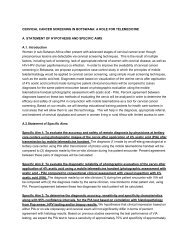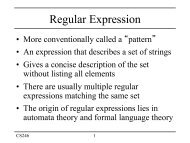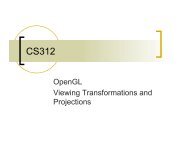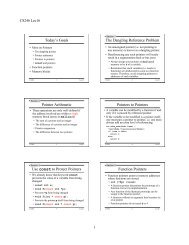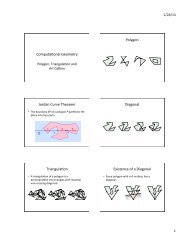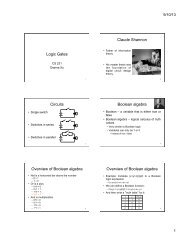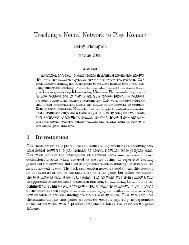Using Robots for the Study of Human Social Development
Using Robots for the Study of Human Social Development
Using Robots for the Study of Human Social Development
You also want an ePaper? Increase the reach of your titles
YUMPU automatically turns print PDFs into web optimized ePapers that Google loves.
<strong>Using</strong> <strong>Robots</strong> <strong>for</strong> <strong>the</strong> <strong>Study</strong> <strong>of</strong> <strong>Human</strong> <strong>Social</strong> <strong>Development</strong><br />
Hideki Kozima and Cocoro Nakagawa and Hiroyuki Yano<br />
National Institute <strong>of</strong> In<strong>for</strong>mation and Communications Technology<br />
Hikaridai 3-5, Seika-cho<br />
Soraku-gun, Kyoto 619-0289, Japan<br />
{xkozima, cocoron, yano}@nict.go.jp<br />
Abstract<br />
We built a child-like humanoid, Infanoid, anda<br />
small creature-like robot, Keepon, bywhichweinvestigate<br />
human social development, especially <strong>of</strong><br />
interpersonal communication. The approach we<br />
take here includes (1) to implement on <strong>the</strong> robots<br />
psychological models <strong>of</strong> social development, (2)<br />
toobservehowhumanchildreninteractwith<strong>the</strong><br />
robots through various social actions like pointing<br />
at and showing objects. These two sides<br />
are complementary: findings from <strong>the</strong> observation<br />
will <strong>the</strong>n be used <strong>for</strong> upgrading <strong>the</strong> robots’ structure<br />
and function, thus <strong>for</strong>ming an elaboration cycle.<br />
This position paper introduces our research<br />
project, Epigenetic Robotics, in which we do both<br />
implementation and observation in order to provide<br />
a promising and productive field <strong>of</strong> synergy<br />
<strong>for</strong> exploring <strong>the</strong> developmental mechanism <strong>of</strong> human<br />
communication.<br />
Introduction<br />
<strong>Development</strong>al Robotics is a newly emerging approach<br />
to modeling and building autonomous artificial intelligence<br />
with <strong>the</strong> human-level adaptability to <strong>the</strong> physical<br />
and social environment. This interdisciplinary field is<br />
expected to provide both developmental psychologists<br />
and AI/robotics researchers with <strong>the</strong> linkage between<br />
<strong>the</strong>ories in <strong>the</strong> laboratories and practices in <strong>the</strong> field<br />
(Breazeal 2000; Zlatev 2001). The most <strong>of</strong> <strong>the</strong> early ef<strong>for</strong>ts<br />
were, however, just trying to transfer <strong>the</strong> psychological<br />
and neurological findings onto robotic plat<strong>for</strong>ms<br />
in ra<strong>the</strong>r ad hoc and restricted settings. In order to<br />
create <strong>the</strong> synergistic effect, AI/robotics should make<br />
more influence on developmental psychology.<br />
In this paper we introduce our research project, Epigenetic<br />
Robotics (Kozima 2001), with an emphasis on<br />
utilizing our robots in psychological research. Since<br />
we are interested in human social development, especially<br />
<strong>of</strong> interpersonal communication (Kaye 1982; Trevar<strong>the</strong>n<br />
2001), (1) <strong>the</strong> cognitive models we implement<br />
on <strong>the</strong> robots have to be evaluated in <strong>the</strong> real social<br />
environment with human interactants, (2) from that<br />
Copyright c○ 2005, American Association <strong>for</strong> Artificial Intelligence<br />
(www.aaai.org). All rights reserved.<br />
Fig. 1 Infanoid, <strong>the</strong> attentive and emotive humanoid.<br />
Fig. 2 Eye-contact and joint attention with Infanoid.<br />
evaluation we need to investigate <strong>the</strong> underlying mental<br />
mechanism <strong>of</strong> human social communication, and (3)<br />
we would like to contribute <strong>the</strong> research outcomes to<br />
<strong>the</strong> pedagogical and clinical fields (Dautenhahn 1999),<br />
from where we have had a great influence. Based on <strong>the</strong><br />
motivations above, we built <strong>the</strong> robots and use <strong>the</strong>m<br />
<strong>for</strong> investigating how humans, especially children and<br />
babies, perceive and act on (and finally relate to) <strong>the</strong><br />
robots.<br />
Building <strong>Robots</strong><br />
To get started, we built a child-like humanoid, Infanoid,<br />
and a small creature-like robot, Keepon, which are capable<br />
<strong>of</strong> primordial embodied communication with humans,<br />
especially children and babies, respectively.
attentive expression<br />
(a) Showing a car (left) and giving a rabbit (right).<br />
emotional expression<br />
Fig. 3 Keepon and its expressive functions.<br />
(b) Playing with agents/objects (left) and feeding (right).<br />
Fig. 5 Children interacting with Infanoid.<br />
Fig. 4 Keepon gazing at a face and <strong>the</strong>n at a toy.<br />
Infanoid — An Upper-torso <strong>Human</strong>oid<br />
Infanoid, shown in Fig. 1, is an upper-torso humanoid<br />
robot which is as big as a 3- to 4-year-old human child<br />
(Kozima 2001, 2002). It has 29 actuators (mostly DC<br />
motors with encoders and torque sensing devices) and a<br />
number <strong>of</strong> sensors arranged in <strong>the</strong> relatively small body.<br />
It has two hands capable <strong>of</strong> pointing, grasping, and a<br />
variety <strong>of</strong> hand gestures; it also has lips and eyebrows<br />
to produce various facial expressions, like surprise and<br />
anger, as shown in Fig. 1, left.<br />
The head <strong>of</strong> Infanoid has two eyes, each <strong>of</strong> which<br />
contains two different color CCD cameras <strong>for</strong> peripheral<br />
and foveal views; <strong>the</strong> eyes can per<strong>for</strong>m saccadic<br />
eye movements and smooth pursuit <strong>of</strong> a visual target.<br />
The video images taken by <strong>the</strong> cameras are fed into a<br />
cluster <strong>of</strong> PCs <strong>for</strong> real-time detection <strong>of</strong> human faces<br />
(<strong>for</strong> eye-contact, as shown in Fig. 2, left) and a primordial<br />
<strong>for</strong>m <strong>of</strong> joint attention (as shown in Fig. 2, right)<br />
by reading <strong>the</strong> human’s face direction to a third object.<br />
From <strong>the</strong> microphones at <strong>the</strong> ears, Infanoid hears<br />
human voices and analyzes <strong>the</strong> sound into a sequence<br />
<strong>of</strong> phonemes. By feeding <strong>the</strong> phoneme string with <strong>the</strong><br />
extracted pattern <strong>of</strong> fundamental frequency, Infanoid<br />
per<strong>for</strong>ms vocal imitations while sharing attention with<br />
<strong>the</strong> interactant.<br />
Keepon — Not a Toy nor a <strong>Human</strong><br />
For psychological experiments with younger children,<br />
we built ano<strong>the</strong>r robot, Keepon (Kozima 2003). Comparing<br />
with Infanoid, which has human-like sophisticated<br />
structure and function, Keepon is a small (12cm<br />
in height, 8cm in diameter), s<strong>of</strong>t (made <strong>of</strong> silicone rubber),<br />
creature-like robot, as shown in Fig. 3, left. It<br />
can per<strong>for</strong>m only two kinds <strong>of</strong> motion, as illustrated in<br />
Fig. 3, right: (1) expressing its attention by orienting<br />
its face to a certain target in <strong>the</strong> environment, and (2)<br />
expressing its emotional states, such as pleasure and excitement,<br />
by rocking its body from left to right and by<br />
bobbing up and down. Keepon is connected by wireless<br />
links to a remote PC, from which a human operator or<br />
a computer program controls <strong>the</strong> motion. Although its<br />
appearance is quite simple, Keepon has two color CCD<br />
cameras and one microphone at <strong>the</strong> nose tip, which provide<br />
almost <strong>the</strong> same audio-visual capabilities as those<br />
<strong>of</strong> Infanoid, as shown in Fig. 4.<br />
Observing Interaction with Children<br />
We carried out a series <strong>of</strong> observations <strong>of</strong> child-robot<br />
interaction, where normal children and mentally challenged<br />
children played with our robots almost without<br />
any experimental constraint.<br />
Interacting with Infanoid<br />
Fourteen normally developing children (about 5 years<br />
old on average) interacted with Infanoid (Kozima<br />
2003). The robot ran in Automatic Mode, in which it<br />
alternates between eye-contact and joint attention with<br />
pointing; if necessary, a remote operator made adjustments<br />
to <strong>the</strong> robot’s attention (e.g. direction <strong>of</strong> <strong>the</strong> gaze<br />
and bodily posture). First, each child was seated alone<br />
in front <strong>of</strong> <strong>the</strong> robot, without having been given any<br />
prior knowledge about <strong>the</strong> robot. About 3 to 4 minutes<br />
later, <strong>the</strong> child’s caregiver (usually mo<strong>the</strong>r) came<br />
in and sat next to <strong>the</strong> child. Interaction continued until<br />
<strong>the</strong> child get tired or bored; on average, each child had<br />
an interaction <strong>of</strong> about 30 minutes.<br />
We found from <strong>the</strong> observations that each child’s ontological<br />
understanding <strong>of</strong> Infanoid changed with <strong>the</strong>
progress <strong>of</strong> <strong>the</strong> interaction in <strong>the</strong> following manner.<br />
• Neophobia phase: For <strong>the</strong> first 3 to 4 minutes, <strong>the</strong><br />
child showed embarrassment, not knowing how to<br />
deal with this moving thing. In fact, <strong>the</strong>re was no<br />
reciprocal interaction, but just staring at <strong>the</strong> robot.<br />
• Exploration phase: Next, by poking <strong>the</strong> robot and<br />
showing his/her hand or toys to <strong>the</strong> robot (Fig. 5<br />
(a), left), <strong>the</strong> child started exploring what stimuli <strong>the</strong><br />
robot could perceive and what action <strong>the</strong> robot could<br />
per<strong>for</strong>m in response.<br />
• Interaction phase: Finally, <strong>the</strong> child gradually got<br />
into <strong>the</strong> loop <strong>of</strong> social exchanges. For example, <strong>the</strong><br />
childrespondedto<strong>the</strong>robot’spointingtoatoyby<br />
handing it to <strong>the</strong> robot (Fig. 5 (a), right), as if he/<br />
she recognized <strong>the</strong> robot as a mental agent that has<br />
desire and likes/dislikes.<br />
In addition, we observed a 6-year-old high-functioning<br />
autistic child interact with Infanoid (Kozima 2004a),<br />
where we found almost <strong>the</strong> same tendency in <strong>the</strong><br />
progress <strong>of</strong> <strong>the</strong> interaction, except that <strong>the</strong> autistic child<br />
did not get bored even after 45 minutes intensive interaction<br />
with <strong>the</strong> robot. For details, refer to (Kozima<br />
2004a).<br />
We hypo<strong>the</strong>sized that children change <strong>the</strong>ir ontological<br />
understanding <strong>of</strong> Infanoid in <strong>the</strong> following way.<br />
First, children recognize <strong>the</strong> robot as a moving thing;<br />
<strong>the</strong>n, observing <strong>the</strong> robot’s motion responding to various<br />
environmental disturbances, <strong>the</strong>y recognize that<br />
<strong>the</strong> robot is an autonomous, subjective system that possesses<br />
attention and emotion as an initiator <strong>of</strong> <strong>the</strong> motion.<br />
Next, <strong>the</strong>y find that <strong>the</strong> robot’s response (in terms<br />
<strong>of</strong> attention and emotion) has a spatio-temporal relation<br />
with what <strong>the</strong>y have done to <strong>the</strong> robot; <strong>the</strong>n, <strong>the</strong>y<br />
recognize <strong>the</strong> robots as an intersubjective companion<br />
with which <strong>the</strong>y can exchange or coordinate <strong>the</strong>ir attention,<br />
emotion, and actions.<br />
Interacting with Keepon<br />
Twenty-three normally developing babies in three different<br />
age groups, namely 0-year-olds (from 6 months <strong>of</strong><br />
age), 1-year-olds, and over-2-year-olds, interacted with<br />
Keepon toge<strong>the</strong>r with <strong>the</strong>ir mo<strong>the</strong>rs (Kozima 2003).<br />
The robot ran in Manual Mode, where a remote operator<br />
controlled <strong>the</strong> robot’s attentional and emotional<br />
expressions manually with <strong>the</strong> help <strong>of</strong> <strong>the</strong> images and<br />
sounds taken by <strong>the</strong> on-board and <strong>of</strong>f-board cameras.<br />
The robot usually alternated between eye-contact (with<br />
<strong>the</strong> baby or <strong>the</strong> mo<strong>the</strong>r) and joint attention (to some<br />
toys on <strong>the</strong> floor); when <strong>the</strong> baby showed any meaningful<br />
response (touching, pointing, etc.), <strong>the</strong> robot made<br />
eye-contact and showed positive emotion by rocking and<br />
bobbing its body. Interaction continued until <strong>the</strong> babies<br />
showed any sign <strong>of</strong> fatigue or boredom; on average,<br />
each baby had an interaction <strong>of</strong> about 10 minutes.<br />
We found from <strong>the</strong> observations almost <strong>the</strong> same<br />
tendency that we found <strong>the</strong> interaction with Infanoid;<br />
however each <strong>of</strong> <strong>the</strong> three age groups showed different<br />
(a) Showing a rabbit (left) and soothing (right).<br />
(b) Challenging <strong>the</strong> robot (left) and pretense play (right).<br />
Fig. 6 Babies/children interacting with Keepon.<br />
depths to which <strong>the</strong>y deepened <strong>the</strong> level <strong>of</strong> <strong>the</strong> interaction.<br />
• 0-year-olds: The interaction was dominated by tactile<br />
exploration using hands and mouth. The babies did<br />
not pay attention to Keepon’s attention.<br />
• 1-year-olds: The babies showed awareness <strong>of</strong><br />
Keepon’s attentional and emotional expressions.<br />
Some mimicked <strong>the</strong> robot’s emotional expressions (by<br />
rocking and bobbing <strong>the</strong>ir bodies).<br />
• 2-year-olds: They socially interacted with Keepon, by<br />
showing toys (Fig. 6 (a), left) <strong>for</strong> instance. When <strong>the</strong><br />
robot’s response was meaningful to <strong>the</strong> babies, <strong>the</strong>y<br />
<strong>of</strong>ten soo<strong>the</strong>d <strong>the</strong> robot by stroking its head (Fig. 6<br />
(a), right).<br />
We assume that <strong>the</strong> different ways each group took in<br />
<strong>the</strong> interaction reflect <strong>the</strong>ir ontological understanding<br />
<strong>of</strong> <strong>the</strong> robot.<br />
Meanwhile, we also longitudinally observed 15 preschool<br />
children (2 to 4 years old) with developmental<br />
disorders (e.g. PDD and autism) interact with Keepon<br />
(Kozima 2004b). We placed Keepon in <strong>the</strong> playroom at<br />
a day-care center <strong>for</strong> children with special needs. The<br />
children, <strong>of</strong>ten with <strong>the</strong>ir parents and nursing staffs,<br />
could interact with Keepon spontaneously anytime during<br />
<strong>the</strong> remedial session (about 3 hours). Through a series<br />
<strong>of</strong> longitudinal observations <strong>for</strong> about five months<br />
(12 to 15 sessions <strong>for</strong> each child), we observed various<br />
types <strong>of</strong> change in <strong>the</strong> children’s ways to interact with<br />
Keepon, each <strong>of</strong> which displays <strong>the</strong> distinctive characteristics<br />
<strong>of</strong> <strong>the</strong> child and his/her difficulties. The video<br />
record <strong>of</strong> <strong>the</strong> interaction that had taken from <strong>the</strong> view<br />
point <strong>of</strong> Keepon and its preliminary analysis are being<br />
used <strong>for</strong> planning and evaluating <strong>the</strong> remedial service.<br />
For details, refer to (Kozima 2004b).
Conclusion<br />
We described here some <strong>of</strong> our preliminary attempts<br />
to utilize interactive robots <strong>for</strong> <strong>the</strong> psychological study<br />
<strong>of</strong> human social development. The child-like humanoid,<br />
Infanoid, and <strong>the</strong> creature-like robot, Keepon, arebeing<br />
used as (1) research plat<strong>for</strong>ms on which we implement<br />
and test our models <strong>of</strong> social intelligence and its development,<br />
(2) tools <strong>for</strong> psychological investigation, where<br />
<strong>the</strong> robots display various types <strong>of</strong> social actions to human<br />
interactants, and (3) a medium through which we<br />
contribute to <strong>the</strong> social needs in <strong>the</strong> pedagogical and<br />
<strong>the</strong>rapeutic practices. These aspects <strong>of</strong> robot utilization<br />
are, <strong>of</strong> course, complementary ones; fur<strong>the</strong>r knowledge<br />
exchange by which <strong>the</strong> researchers could share <strong>the</strong>ir<br />
seeds and needs is certainly important <strong>for</strong> <strong>the</strong> success<br />
<strong>of</strong> this interdisciplinary undertaking.<br />
Acknowledgments<br />
The authors are grateful to <strong>the</strong> following people who<br />
have collaborated with <strong>the</strong> authors in <strong>the</strong> psychological<br />
experiments on human-robot interaction: Yuriko<br />
Yasuda (Omihachiman City Day-Care Center <strong>for</strong> Children<br />
with Special Needs), Nobuyuki Kawai (Nagoya<br />
University), Yoshio Yano (Kyoto University <strong>of</strong> Education),<br />
Daisuke Kosugi (Shizuoka Institute <strong>of</strong> Science<br />
and Technology), and Chizuko Murai (Kyoto University).<br />
with children, to appear in Proceedings <strong>of</strong> <strong>the</strong> International<br />
Workshop on <strong>Human</strong>oid Robotics (<strong>Human</strong>oids-<br />
04, Santa Monica, USA), 2004.<br />
(Kozima 2004b) Kozima, H., Nakagawa, C., Yasuda,<br />
Y., and Kosugi, D. A toy-like robot in <strong>the</strong> playroom<br />
<strong>for</strong> children with developmental disorder, to appear<br />
in Proceedings <strong>of</strong> <strong>the</strong> International Conference on <strong>Development</strong><br />
and Learning (ICDL-04, San Diego, USA),<br />
2004.<br />
(Zlatev 2001) Zlatev, J. and Balkenius, C. Introduction:<br />
Why “epigenetic robotics”?, in Proceedings <strong>of</strong> <strong>the</strong><br />
First International Workshop on Epigenetic Robotics<br />
(EpiRob-01, Lund, Sweden), 2001.<br />
(Trevar<strong>the</strong>n 2001) Trevar<strong>the</strong>n, C. Intrinsic motives <strong>for</strong><br />
companionship in understanding: <strong>the</strong>ir origin, development,<br />
and significance <strong>for</strong> infant mental health, Infant<br />
Mental Health Journal, Vol. 22, pp. 95–131, 2001.<br />
References<br />
(Breazeal 2000) Breazeal, C. and Scassellati, B.<br />
Infant-like social interactions between a robot and a<br />
human caretaker, Adaptive Behavior, Vol. 8, pp. 49–<br />
74, 2000.<br />
(Dautenhahn 1999) Dautenhahn, K. <strong>Robots</strong> as social<br />
actors: Aurora and <strong>the</strong> case <strong>of</strong> autism, in Proceedings<br />
<strong>of</strong> <strong>the</strong> International Cognitive Technology Conference,<br />
pp. 359–374, 1999.<br />
(Kaye 1982) Kaye, K. The Mental and <strong>Social</strong> Life <strong>of</strong><br />
Babies, University <strong>of</strong> Chicago Press, 1982.<br />
(Kozima 2001) Kozima, H. and Hiroyuki Yano A<br />
robot that learns to communicate with human caregivers,<br />
in Proceedings <strong>of</strong> <strong>the</strong> First International Workshop<br />
on Epigenetic Robotics (EpiRob-01, Lund, Sweden),<br />
2001.<br />
(Kozima 2002) Kozima, H. Infanoid: A babybot that<br />
explores <strong>the</strong> social environment, in Dautenhahn, K. et<br />
al. (eds), <strong>Social</strong>ly Intelligent Agent, KluwerAcademic<br />
Publishers, pp. 157–164, 2002.<br />
(Kozima 2003) Kozima, H., Nakagawa, C., and Yano,<br />
H. Attention coupling as a prerequisite <strong>for</strong> <strong>the</strong> social<br />
interaction, in Proceedings <strong>of</strong> <strong>the</strong> International<br />
Workshop on <strong>Human</strong>-Robot Interactive Communication<br />
(ROMAN-03, San Francisco, USA), 2003.<br />
(Kozima 2004a) Kozima, H., Nakagawa, C., Kawai,<br />
N., Kosugi, D., and Yano, Y. A humanoid in company




